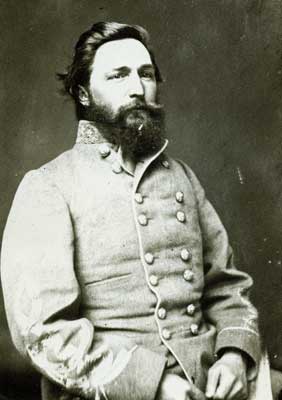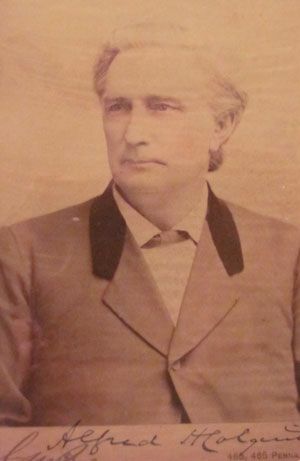Brigadier General Alfred Holt Colquitt
(1824-1894)
 Library of Congress |
 Valentine Museum |
 Library of Congress |
 Valentine Museum |
Brigadier General Finegan's most reliable force was Colquitt's Brigade, a collection of veteran units that had seen action in Virginia, Maryland and the Carolinas. Its commander was Brigadier General Alfred Colquitt, a thirty-nine year old, full-bearded Georgian, who was the son of a prominent, antebellum politician. Alfred Colquitt was an 1844 graduate of Princeton, whose pre-war law career was interrupted by service in the Mexican War as a staff major, followed by service in both the U.S. House of Representatives and the Georgia Senate.
An ardent secessionist, Colquitt served as presidential elector for John C. Breckinridge in 1860, and, upon the outbreak of war, was appointed captain of a company in the Sixth Georgia Infantry. Elected colonel of the regiment in May 1861, and subsequently placed in command of a brigade, Colquitt participated in the defense of Richmond in the spring of 1862. On 1 September 1862, he was promoted to brigadier general and served as brigade commander under Jackson at Antietam, Fredericksburg and Chancellorsville.
Prior to Chancellorsville, Colquitt's performance had been capable, if not spectacular. In this last battle, however, his hesitation during Jackson's flank attack on 2 May 1863, in the mistaken belief that Union cavalry was massing in his front, slowed the Confederate onslaught and led to criticism of his abilities. Douglas Southall Freeman, noted historian of Lee's Army of Northern Virginia, writes that Colquitt showed "doubtful achievement" at Chancellorsville and, "concerning him, the question fundamentally was one of judgment."
After this campaign, Colquitt and his "depleted" brigade were first transferred from Virginia to North Carolina, then eventually to Charleston. They participated in the defense of the city during the summer and fall of 1863. Arriving in Florida only days before the Federal advance, Colquitt's troops were the most experienced troops available to General Finegan. Undoubtedly, Colquitt still keenly felt the disappointment and embarrassment of his poor showing at Chancellorsville, and was anxious to atone for his actions. While a skirmish in the Florida pines could hardly compare with Virginia's pitched battles, a victory here might end the Georgian's exile to the backwaters of the war, and help polish his somewhat tarnished image.
Colquitt's brigade of Georgia veterans, consisted of the Sixth, Nineteenth, Twenty-third, Twenty-seventh, and Twenty-eighth Infantry regiments. Added to these units were the Sixth Florida Infantry Battalion, the Chatham Artillery from Georgia and the Leon Light Artillery from Florida.. The arrival of Colquitt's Brigade was a welcome addition to the Confederate force, and in the coming battle, it was to prove its fighting ability.
Praised as the "Hero of Olustee" for his leadership during the battle, Colquitt continued his service during 1864-1865 with Lee's army in Virginia. Late in the war, Colquitt and his brigade were transferred to North Carolina, where they surrendered in 1865. In the post-Reconstruction years Colquitt served as governor of Georgia and then as a United States Senator.
Unfortunately for students of the Civil War, Confederate memoirs, reminiscences and regimental histories were written in far fewer numbers than similar Union works. Thus the history of many Confederate regiments is not as complete as for U.S. Federal units.
The history of the different regiments comprising Colquitt's Brigade has already been largely traced through their commander's exploits. All of the regiments were organized in Georgia during the first year of the war. The Sixth was mustered in service at Atlanta, the Nineteenth and Twenty-third at Camp McDonald at Big Shanty, and the Twenty-eighth at Camp Stephens, near Griffin. After initial training in Georgia, the regiments were transported to Virginia. Here they joined the Confederate army that would gain fame as the Army of Northern Virginia, and participated in all the major campaigns of that force through Chancellorsville.
In the late spring of 1863, the brigade, along with its commander, was transferred to the lower Atlantic coast. After a brief stay in North Carolina, they were sent to aid in the defense of besieged Charleston, where they remained for the rest of the year.
At the time of their organization, these units included some of the finest military material of the state. Their companies had glamorous names like the Palmetto Guards, Georgia Dillers, Gold Diggers, Jefferson Greys, Bartow Invincibles, Taylor Guards, Cherokee Field Guards, Confederate Invincibles, Sandersonville Volunteers, Ohoopee Guards, Baker County Fire Eaters, Irwin Volunteers and the Bartow Yankee Killers. After three years of grim warfare most of the glamour had faded. Many of the regiments had been decimated by casualties and disease. For example, in a book published late in 1864, the commander of the Nineteenth reported that 1,258 men had served in the regiment, and it had suffered total losses, including casualties, discharged, deserted and transferred, of 1,237. (This included many men who were wounded more than once.) Although greatly reduced in numbers, the surviving members of these regiments had evolved into superb, veteran fighters, made even more ruthless by the knowledge that a Union invasion of Florida might soon bring their home state under attack. During the fighting at Olustee the brigade suffered official casualties of 43 killed, 441 wounded and two missing.
BGen Colquitt's Report of the Battle


External Web sites related to the Battle of Olustee
Wikipedia page on General Colquitt
Confederate Order of Battle
Battle of Olustee home page
http://battleofolustee.org/